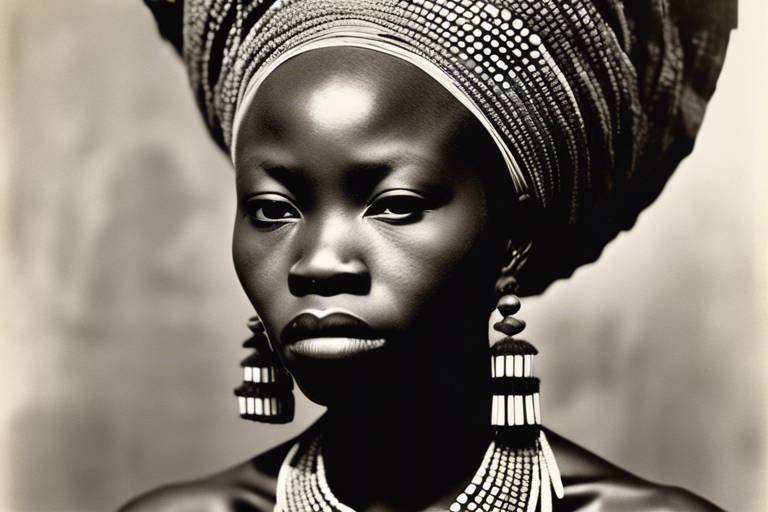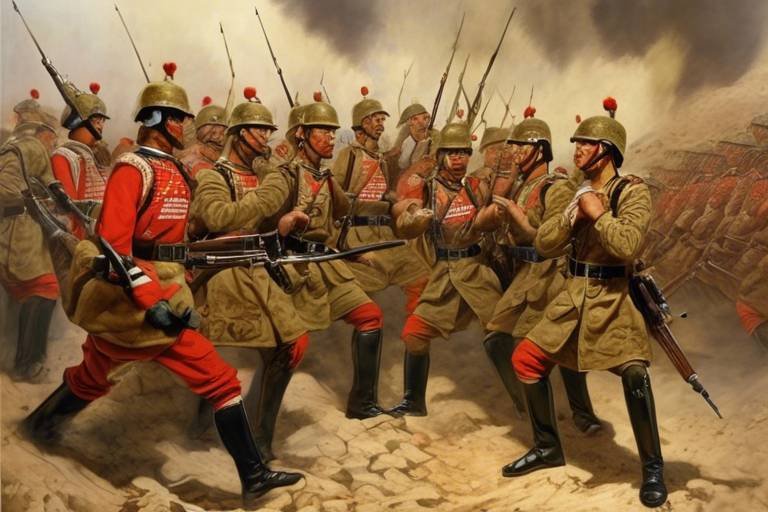The Aesthetic Traditions of Caribbean Art
Exploring the rich and diverse artistic heritage of the Caribbean region reveals a fascinating fusion of indigenous, African, European, and Asian influences. The art of the Caribbean is a vibrant tapestry woven with the threads of history, culture, and identity, reflecting the soul of its people.

Indigenous Influences
Exploring the rich and diverse artistic heritage of the Caribbean region, encompassing a fusion of indigenous, African, European, and Asian influences. From vibrant colors to intricate patterns, Caribbean art reflects the history, culture, and identity of its people.
The indigenous peoples of the Caribbean, including the Taino, Carib, and Arawak tribes, have deeply influenced the art scene of the region. Their artistic practices, ranging from pottery to weaving and petroglyphs, serve as a wellspring of inspiration for contemporary Caribbean artists. The intricate patterns and symbolic motifs found in indigenous art continue to resonate in modern artworks, bridging the gap between the past and the present.

African Roots
The artistic expressions of the Caribbean region bear profound influences from the rich and diverse heritage of African art and culture. Through centuries of transatlantic slave trade and cultural exchanges, African traditions have become deeply intertwined with the artistic identity of the Caribbean.
Traditional African art forms, such as intricate wood carvings, vibrant textiles, and symbolic masks, have left an indelible mark on Caribbean artistic practices. These visual motifs and storytelling techniques, rooted in ancestral rituals and ceremonies, continue to resonate in the works of contemporary Caribbean artists.
Moreover, the resilience and creativity of African descendants in the Caribbean have led to the evolution and adaptation of traditional art forms. The fusion of African aesthetics with local influences has resulted in a unique artistic language that speaks to the shared history and experiences of the Afro-Caribbean community.
Caribbean artists draw inspiration from the spiritual, cultural, and social aspects of African heritage, infusing their creations with symbolism and meaning that reflect the struggles and triumphs of the African diaspora. The vibrancy and dynamism of African artistry continue to shape the aesthetic traditions of the Caribbean, celebrating resilience, identity, and cultural pride.

European Aesthetics
The influence of European aesthetics on Caribbean art is profound and multifaceted. European colonization brought new artistic techniques, styles, and subject matters to the region, blending with the existing indigenous and African influences to create a unique artistic identity. The European artistic traditions, ranging from Baroque and Rococo to Neoclassicism and Romanticism, found their way into Caribbean art, enriching it with diverse elements. The intricate details of European paintings, the use of perspective, and the portrayal of religious and historical themes all left a lasting impact on Caribbean artists.
The fusion of European aesthetics with local Caribbean culture gave rise to new art forms and expressions that reflected the complex history of the region. Artists began incorporating European techniques such as oil painting and sculpture into their work, adapting them to convey their own narratives and perspectives. The European influence also extended to the subject matter of Caribbean art, with depictions of landscapes, portraits, and religious scenes becoming prevalent in the artistic production of the time.
Moreover, European art movements like Impressionism and Cubism inspired Caribbean artists to experiment with different styles and interpretations, leading to the development of a diverse artistic landscape. The interplay between European aesthetics and Caribbean sensibilities continues to shape the art scene in the region, with contemporary artists drawing inspiration from both traditional European masters and modern artistic trends.

Asian Inspirations
Asian art has played a significant but often overlooked role in shaping the creative landscape of the Caribbean. While European and African influences are more commonly discussed, Asian inspirations have quietly contributed to the region's diverse artistic expressions. From the delicate beauty of Chinese porcelain to the vibrant colors of Indian textiles, Asian aesthetics have found a place within the tapestry of Caribbean art.
One notable example of Asian influence in Caribbean art is the incorporation of intricate patterns and motifs reminiscent of traditional Asian designs. These elements add a unique flair to the artwork, blending seamlessly with the region's indigenous and colonial influences. The fusion of Asian inspirations with local artistic traditions has resulted in a rich and dynamic visual language that sets Caribbean art apart.
Moreover, the techniques and craftsmanship associated with Asian art forms have inspired Caribbean artists to experiment with new mediums and styles. The attention to detail and precision found in Asian artistic practices have influenced the way Caribbean artists approach their work, leading to innovative interpretations and creative expressions.
While the impact of Asian art on Caribbean creativity may not always be overt, its presence can be felt in the subtle nuances and nuances of the region's artistic output. By embracing Asian inspirations alongside indigenous, African, and European influences, Caribbean artists continue to expand the boundaries of their art, creating a truly multicultural and vibrant artistic landscape.

Modern Interpretations
Exploring the rich and diverse artistic heritage of the Caribbean region, encompassing a fusion of indigenous, African, European, and Asian influences. From vibrant colors to intricate patterns, Caribbean art reflects the history, culture, and identity of its people.
In the realm of modern interpretations of Caribbean art, artists are constantly pushing boundaries and reimagining traditional aesthetic elements. Through innovative techniques and mediums, they breathe new life into age-old practices, creating a dynamic and evolving artistic landscape.
Contemporary Caribbean artists often draw inspiration from a myriad of sources, blending indigenous, African, European, and Asian influences to create unique and thought-provoking pieces. This fusion of cultural elements results in artworks that are not only visually striking but also deeply meaningful, resonating with audiences on a global scale.
One notable trend in modern Caribbean art is the use of mixed media, where artists combine various materials and techniques to convey complex narratives and emotions. By experimenting with different forms of expression, these artists challenge conventional notions of what Caribbean art should be, opening up new possibilities for creative exploration.
Moreover, modern interpretations of Caribbean art often serve as a platform for artists to engage with contemporary issues and themes. From environmental concerns to social justice movements, artists use their work as a means of sparking dialogue and provoking reflection, making a powerful impact on both local and international audiences.
Overall, the modern interpretations of Caribbean art showcase the region's vibrant cultural tapestry and the dynamic evolution of artistic expression. By embracing innovation and creativity, contemporary artists continue to shape and redefine the artistic landscape of the Caribbean, leaving a lasting legacy for future generations to appreciate and be inspired by.
Coming soon...

Political and Social Commentary
Political and Social Commentary in Caribbean art serves as a powerful vehicle for artists to voice their perspectives on pressing issues within the region. Through their creations, artists delve into themes of identity, race, politics, and social justice, sparking conversations and provoking thought among viewers. By infusing their art with messages of dissent and advocacy, Caribbean artists aim to bring attention to societal inequalities and push for positive change.

Global Influence
The impact of globalization on Caribbean art cannot be understated. As the world becomes increasingly interconnected, Caribbean artists are engaging with international trends, technologies, and dialogues to expand their creative horizons. This global influence brings both new opportunities and challenges to the artistic landscape of the region.
Through collaborations with artists from around the world, Caribbean creatives are exposed to diverse perspectives and artistic practices, enriching their own work. The exchange of ideas and techniques fosters innovation and cross-cultural dialogue, leading to the evolution of Caribbean art in exciting new directions.
Furthermore, the digital age has revolutionized the way art is created, shared, and consumed. Social media platforms and online galleries provide Caribbean artists with unprecedented visibility and access to global audiences. This digital presence not only promotes their work on an international scale but also facilitates connections with art enthusiasts and collectors worldwide.
However, globalization also poses challenges to Caribbean artists, as they navigate issues of cultural appropriation, commodification, and authenticity in a globalized art market. Balancing the preservation of their cultural heritage with the demands of a global audience requires careful consideration and strategic decision-making.
Despite these challenges, the global influence on Caribbean art opens up a world of possibilities for artists to explore, experiment, and thrive in a dynamic and interconnected art world. By embracing the opportunities presented by globalization while staying true to their roots, Caribbean artists continue to make a significant impact on the global artistic landscape.

Preserving Cultural Heritage
Preserving Cultural Heritage in the Caribbean is a vital endeavor that seeks to safeguard the rich artistic traditions and historical narratives of the region for future generations. Museums and galleries play a crucial role in this preservation effort by curating exhibitions that showcase the diverse artistic expressions of the Caribbean. These institutions serve as custodians of invaluable artworks, artifacts, and documents that encapsulate the cultural heritage of the Caribbean.
Furthermore, cultural festivals and events celebrate the vibrant artistic legacy of the Caribbean, providing a platform for artists to exhibit their work and engage with the public. These gatherings not only promote local talent but also foster a sense of community and pride in the artistic heritage of the region. Educational initiatives aimed at teaching traditional artistic techniques and promoting cultural awareness among the youth are also instrumental in preserving Caribbean heritage.
Collaborations between local artists, international organizations, and academic institutions contribute to the documentation and conservation of Caribbean art forms. Through research, restoration projects, and digital archiving, efforts are made to ensure that the intricate details and stories behind each artwork are preserved for posterity. By investing in the preservation of cultural heritage, the Caribbean honors its past and enriches its future artistic landscape.
Frequently Asked Questions
- What is the significance of indigenous influences in Caribbean art?
The indigenous influences in Caribbean art hold great significance as they reflect the deep-rooted cultural heritage of the region. Art forms such as pottery, weaving, and petroglyphs from tribes like the Taino, Carib, and Arawak continue to inspire contemporary artists, showcasing a connection to the land and history.
- How has African culture impacted Caribbean artistic expressions?
African culture has had a profound impact on Caribbean art, influencing everything from visual motifs to storytelling techniques. The rich legacy of African heritage is evident in various art forms throughout the region, adding layers of symbolism and meaning to the artistic narrative.
- What role does European colonization play in shaping Caribbean art?
European colonization played a significant role in shaping Caribbean art by introducing new techniques, styles, and subject matters to the region. The fusion of European artistic traditions with local influences created a unique aesthetic that defines much of Caribbean art today, showcasing a blend of diverse cultural elements.
- How have contemporary Caribbean artists reinterpreted traditional aesthetic elements?
Contemporary Caribbean artists have reinterpreted traditional aesthetic elements in their work by employing innovative techniques and mediums. Through their creations, they push boundaries and challenge conventional notions of Caribbean art, infusing new energy and perspectives into the artistic landscape.
- Why is art considered a powerful tool for addressing social and political issues in the Caribbean?
Art serves as a powerful tool for addressing social and political issues in the Caribbean as it provides a platform for expression and dissent. Artists use their work to raise awareness, advocate for change, and spark important conversations about identity, race, politics, and social justice in the region.



















